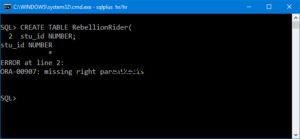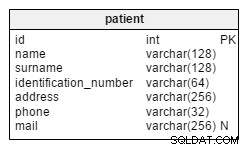Zakładam, że powinno to spowodować wydrukowanie „Null asocjacyjnej tablicy”. To założenie jest błędne w przypadku tablic asocjacyjnych. Istnieją, gdy są zadeklarowane, ale są puste. Byłoby to poprawne dla innych typów kolekcji PL/SQL:
Porównaj:
SQL> declare
2 type varchar2_100_aa is table of varchar2(100) index by binary_integer;
3 test varchar2_100_aa;
4 begin
5 test(1) := 'Hello';
6 dbms_output.put_line(test(1));
7 end;
8 /
Hello
PL/SQL procedure successfully completed.
SQL> declare
2 type varchar2_100_va is varray(100) of varchar2(100);
3 test varchar2_100_va;
4 begin
5 test(1) := 'Hello';
6 dbms_output.put_line(test(1));
7 end;
8 /
declare
*
ERROR at line 1:
ORA-06531: Reference to uninitialized collection
ORA-06512: at line 5
Tablica zmiennych wykonana poprawnie:
SQL> declare
2 type varchar2_100_va is varray(10) of varchar2(100);
3 test varchar2_100_va;
4 begin
5 test := varchar2_100_va(); -- not needed on associative array
6 test.extend; -- not needed on associative array
7 test(1) := 'Hello';
8 dbms_output.put_line(test(1));
9 end;
10 /
Hello
PL/SQL procedure successfully completed.
Ponieważ tablica asocjacyjna jest pusta first i last są null, dlatego drugi przykład daje wynik ORA-06502: PL/SQL: Numeric or value error :
SQL> declare
2 type varchar2_100_aa is table of varchar2(100) index by binary_integer;
3 test varchar2_100_aa;
4 begin
5 dbms_output.put_line(test.count);
6 dbms_output.put_line(coalesce(to_char(test.first), 'NULL'));
7 dbms_output.put_line(coalesce(to_char(test.last), 'NULL'));
8 test(1) := 'Hello';
9 dbms_output.new_line;
10 dbms_output.put_line(test.count);
11 dbms_output.put_line(coalesce(to_char(test.first), 'NULL'));
12 dbms_output.put_line(coalesce(to_char(test.last), 'NULL'));
13 end;
14 /
0
NULL
NULL
1
1
1
PL/SQL procedure successfully completed.
EDYTUJ Zauważ też, że tablice asocjacyjne mogą być rzadkie. Zapętlanie liczb między first i last zgłosi wyjątek dla każdej kolekcji, która jest rzadka. Zamiast tego użyj first i next
tak:(Last i prev aby wykonać pętlę w innym kierunku).
SQL> declare
2 type varchar2_100_aa is table of varchar2(100) index by binary_integer;
3 test varchar2_100_aa;
4 i binary_integer;
5 begin
6 test(1) := 'Hello';
7 test(100) := 'Good bye';
8 dbms_output.put_line(test.count);
9 dbms_output.put_line(coalesce(to_char(test.first), 'NULL'));
10 dbms_output.put_line(coalesce(to_char(test.last), 'NULL'));
11 dbms_output.new_line;
12 --
13 i := test.first;
14 while (i is not null) loop
15 dbms_output.put_line(to_char(i, '999') || ' - ' || test(i));
16 i := test.next(i);
17 end loop;
18 end;
19 /
2
1
100
1 - Hello
100 - Good bye
PL/SQL procedure successfully completed.




